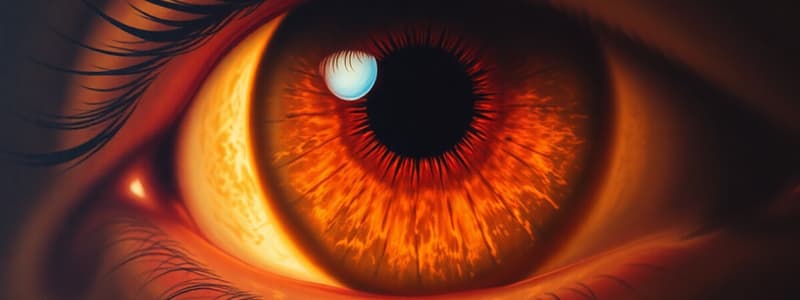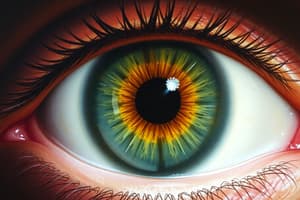Podcast
Questions and Answers
What characterizes wet age-related macular degeneration (AMD)?
What characterizes wet age-related macular degeneration (AMD)?
- Gradual distortion of peripheral vision
- Development of new blood vessels under the retina (correct)
- Slow progressive atrophy of the retina
- Increased visual acuity in low light
Which of the following is NOT a risk factor for developing age-related macular degeneration?
Which of the following is NOT a risk factor for developing age-related macular degeneration?
- Having a family history of the condition
- Being female
- Caucasian ethnicity
- Being under 60 years of age (correct)
What does the Amsler grid test help patients monitor?
What does the Amsler grid test help patients monitor?
- Peripheral vision changes
- Visual acuity under different light conditions
- Eye pressure levels and potential glaucoma
- Distortion or loss of central vision (correct)
What is considered the gold standard for evaluating the retina for changes related to AMD?
What is considered the gold standard for evaluating the retina for changes related to AMD?
Which treatment is specifically used for wet AMD?
Which treatment is specifically used for wet AMD?
Which of the following is a recommended patient education point for managing AMD?
Which of the following is a recommended patient education point for managing AMD?
What is a primary goal of assessing daily living needs for patients with AMD?
What is a primary goal of assessing daily living needs for patients with AMD?
What is one of the treatment strategies included in the AREDS for AMD?
What is one of the treatment strategies included in the AREDS for AMD?
What is the primary characteristic of Diabetic Retinopathy in its early stages?
What is the primary characteristic of Diabetic Retinopathy in its early stages?
Which of the following is a common diagnostic tool for identifying Diabetic Retinopathy?
Which of the following is a common diagnostic tool for identifying Diabetic Retinopathy?
What is the most likely treatment approach for a patient with Diabetic Retinopathy?
What is the most likely treatment approach for a patient with Diabetic Retinopathy?
Which clinical finding is NOT typically associated with Non-Proliferative Diabetic Retinopathy (NPDR)?
Which clinical finding is NOT typically associated with Non-Proliferative Diabetic Retinopathy (NPDR)?
What lifestyle change is emphasized for patients with Diabetic Retinopathy?
What lifestyle change is emphasized for patients with Diabetic Retinopathy?
What is the primary cause of vision changes associated with Macular Degeneration?
What is the primary cause of vision changes associated with Macular Degeneration?
Which condition is closely monitored to prevent microvascular complications in diabetic patients?
Which condition is closely monitored to prevent microvascular complications in diabetic patients?
Laser photocoagulation is utilized in the treatment of which condition?
Laser photocoagulation is utilized in the treatment of which condition?
Flashcards are hidden until you start studying
Study Notes
Diabetic Retinopathy
- A non-inflammatory retinal disorder primarily affecting patients with uncontrolled hyperglycemia.
- Typically asymptomatic in early stages, but later manifests as progressive, painless, vision loss.
- Fundoscopic exam reveals changes:
- Non-proliferative diabetic retinopathy (NPDR)
- Microaneurysms
- Intraretinal hemorrhage
- Macular edema
- Lipid deposits
- Cotton wool spots
- Venous beading and dilation
- Edema
- Retinal hemorrhage
- Diagnosis confirmed by a comprehensive eye exam including visual acuity and assessing the iris, lens, vitreous, and fundus.
- Fluorescein angiography is also helpful.
- Differentiated from other causes of retinopathy such as hypertensive retinopathy, radiation retinopathy, and retinal venous obstruction based on history of diabetes, especially >10 years, and fundoscopic findings.
- Treatment focuses on preventing further microvascular complications:
- Tight blood sugar control (HgbA1c less than 7%).
- Referral to an ophthalmologist upon diagnosis with yearly eye exams.
- Laser photocoagulation for proliferative retinopathy and clinically significant macular edema.
- Vitrectomy for severe cases.
- Tight blood pressure control for patients with diabetes and hypertension using ACE inhibitors like Lisinopril to prevent end organ damage.
- Patient education focuses on:
- Maintaining optimal control of diabetes and hypertension.
- Lifestyle modifications.
- Emphasizing the significance of ophthalmological evaluations and follow-up.
Macular Degeneration (AMD)
- A progressive age-related disease, leading cause of blindness in patients over 50 years old.
- Affects central vision, causing difficulties with reading, facial detail recognition, and performing Activities of Daily Living (ADLs) related to vision.
- Classified as dry or wet.
- Dry AMD: Slow, progressive atrophy of the retina.
- Wet AMD: Development of new blood vessels under the retina in the macula leading to sudden distortion or loss of central vision.
- Risk factors:
- Caucasian ethnicity
- Female sex
- Age over 60
- Cigarette smoking
- Family history (macular degeneration gene)
- Physical exam and diagnostics:
- Evaluate visual acuity:
- Vision less than 20/20 checked with the pinhole test.
- Assess external eye structures.
- Amsler grid assessment.
- Measure contrast sensitivity.
- Dilated eye exam to visualize the retina, specifically looking for macular changes like Drusen and pigment changes are the gold standard.
- Evaluate visual acuity:
- Differentials:
- Vitreous hemorrhage
- Retinal detachment
- Uveitis
- Retrobulbar optic neuritis
- Vascular occlusion
- Treatment:
- No cure for AMD.
- Referral to ophthalmologist.
- Thermal laser photocoagulation (wet AMD).
- Injections directly into the eye (anti-VEGF) monthly or as needed.
- Age-related eye disease study (AREDS): vitamins and supplements including Vitamin C, Vitamin E, beta carotene, zinc, and copper.
- Clinical trials exploring submacular surgery, photodynamic therapy, irradiation, antioxidants, and phytochemicals.
- Patient education:
- Recognize signs and symptoms of advancing disease using the Amsler grid for self-monitoring.
- Smoking cessation, management of hypertension and obesity.
- Rehabilitation services.
- Assess daily living needs and ensure access to optical aids.
- Focus on fall prevention in the home.
- Openly discuss quality of life and assess for depression.
Studying That Suits You
Use AI to generate personalized quizzes and flashcards to suit your learning preferences.




